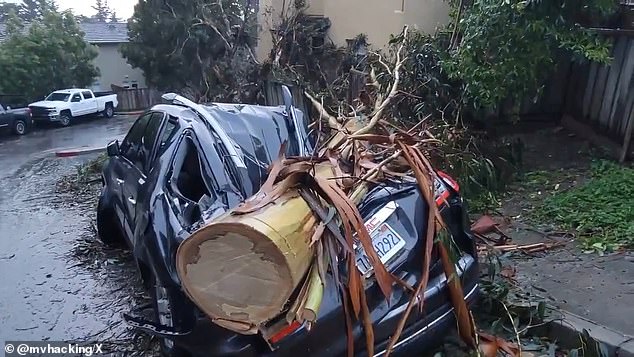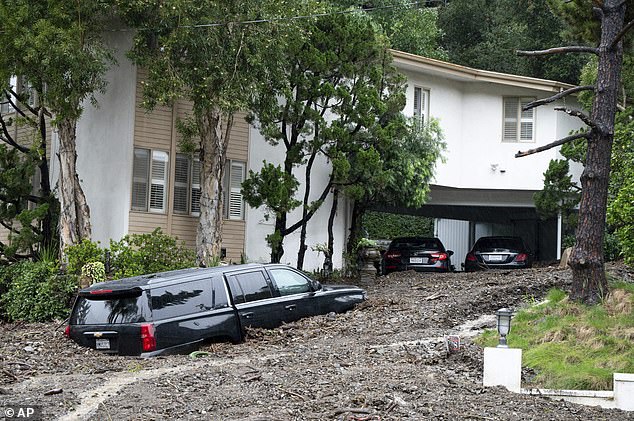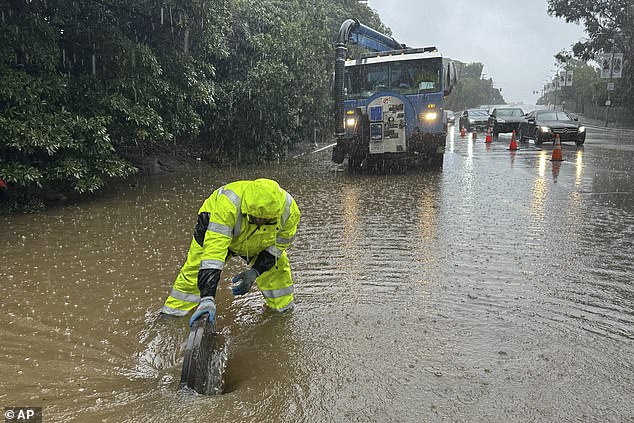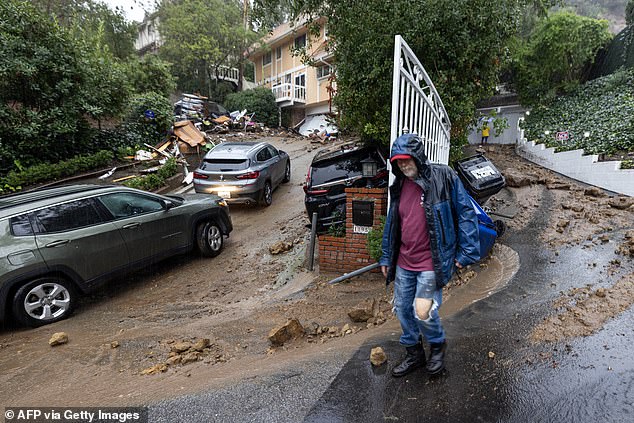What is an atmospheric river? Expert explains why California is experiencing record rainfall and devastating flooding that has left three dead so far, and reveals what lies ahead
Three people have died in the historic flooding that occurred Californiadestroying homes and communities across the state.
Back-to-back ‘Pineapple Express’ storms, fueled by an atmospheric river, have caused chaos in neighborhoods in Malibu, Beverly Hills and Montecito.
The weather system has downed power lines and trees in the San Francisco Bay Area and San Diego, while the state is experiencing heavy mudslides and heavy rain.
Forecasters predict the atmospheric river will continue to focus on all of Southern California over the next 12 to 24 hours, with a significant threat of life-threatening flash flooding remaining.
Qian Ciao, a hydrologist at the University of California, San Diego, explains why these devastating floods are happening.
Three people have been killed as a weather system – the Pineapple Express – continues to ravage California

Nine inches of rain have already fallen in parts of the state, and forecasters predict another six inches will fall. Imagine a tree that fell on a car during the California flood
What is an atmospheric river?
Atmospheric rivers are relatively long and narrow areas that transport water vapor outside the tropics.
Qian Cao explained PBS that they are ‘like a river in the sky’ and can be as long as 1,000 miles.
Normally, atmospheric rivers have double the usual flow of the Amazon and are responsible for most of the world’s water vapor, NASA reports.
When this traveling water vapor collides with mountains or abnormal local weather, it is forced to fall, meaning the moisture it contains becomes colder and causes heavy rainfall or snowfall.
Atmospheric rivers can occur anywhere in the world, but they are most often found in the middle latitudes of the planet – about 30 to 60 degrees north or south of the equator.
This weather phenomenon usually occurs when large-scale weather patterns synchronize and form narrow stretches of intense moisture transport, Mr. Cao explains.
He told the PBS: ‘These start over warm waters, typically tropical oceans, and are guided offshore by low-level jet streams ahead of cold fronts from extratropical cyclones.’
The hydrologist revealed that the Pacific Ocean, which runs along the west coast of the US, acts as a moisture pool for storms.
This, together with the mountainous terrain of the area acting as a barrier, causes a lot of snow and rain in the state, namely the Sierra Nevada.

Atmospheric rivers are relatively long and narrow areas that transport water vapor outside the tropics. Pictured is a large mudslide in Los Angeles
Do successive atmospheric rivers pose a high flood risk?
Back to back atmospheric rivers. also called AR families, can cause significantly heavy flooding. the hydrologist explained.
The first period of heavy rainfall saturates the ground, meaning that when more rainfall or storms arrive, the ground can no longer absorb liquid, meaning water builds up as river levels continue to rise.
In addition, warm temperatures can cause existing snow to melt, contributing to water overflow and the risk of flooding.
According to PBS, California was hit by nine atmospheric rivers in just three weeks straight between December 2022 and January 2023.
Although they restored most of the area’s reservoirs to their average levels after many years of drought, they also caused flood damage.
Compared to a single atmospheric river, AR families are usually associated with lower atmospheric pressure in the North Pacific and again with higher pressure in the subtropics.
AR families are more intense, have warmer tropical temperatures, and are followed by jet streams longer than a single atmospheric river.
Research by scientists at the University of Florida and Stanford found that storms that occur next to AR families cause up to three to four times as much economic damage as a single storm.

While AR families contribute to much of California’s water supply, they also cause extreme flooding and damage (Photo: A vortex forms around a city worker in Los Angeles’ Holmby Hills neighborhood on Monday)
Are atmospheric rivers essential to the West Coast’s water supply?
While atmospheric rivers can cause extreme flooding, Cao explains that they are also critical to Western water supplies.
He said: ‘Atmospheric rivers have been responsible for ending more than a third of the region’s major droughts, including California’s severe drought from 2012-2016.’
The hydrologist added that this type of weather phenomenon is also responsible for 30 to 50 percent of rainfall on the US West Coast.
According to Mr. Cao, atmospheric rivers are responsible for increasing the Sierra Nevada snowpack, which provides a significant portion of California’s water supply.
On average, two heavy atmospheric rivers will contribute about 30 to 40 percent of the snowfall in the Sierra Nevada.
As a result, experts at the Center for Western Weather and Water Extremes are trying to better predict atmospheric rivers so that reservoirs can be better managed to both accommodate storms and have enough water for drier weather conditions.

Hydrologist Qian Ciao predicts that as temperatures rise, more intense atmospheric rivers will form in the coming years (Photo: Studio City storm damage)
Does global warming affect atmospheric rivers?
A warmer atmosphere can transport more moisture, meaning that as temperatures rise in the future, atmospheric rivers will form that will be more intense.
According to Mr Cao, this will result in more heavy rain showers and extreme weather conditions.
He added that his research illustrates that atmospheric rivers are likely to co-occur in weather conditions that are already wet.
According to the hydrologist, this means there is an increased risk of extreme flooding.
A study by academics at the University of Washington shows that atmospheric rivers will experience a “seasonal shift,” occurring earlier in the wetter seasons.
The hydrologist explained that annual rainfall, especially in California, will vary more drastically from year to year.
